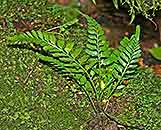Asplenium sulcatum Lam.
Synonyms |
Asplenium auritum Sw. |
|---|---|
Common name |
|
Description |
Rhizome erect to sub-erect, up to 10 mm; rhizome scales dark brown, entire, apex tapering to a point, up to 6 mm long. Fronds tufted, arching, thinly coriaceous, not proliferous, dimorph with the sterile fronds half the size of the fertile fronds. Stipe 5-22 cm, matt grey to greyish green, glabrous. Lamina 8-26 cm × 3.2-10 cm, pinnate to 2-pinnate, triangular-lanceolate in outline, basal pinnae not reduced, decrescent upwards into a deeply pinnatifid apex. Pinnae up to 15 pairs, 1.8-5.5 x 0.4-2 cm, petiolate, lanceolate in outline, apex obtuse to acute, base asymmetrical cuneate, margins incised more than 1/2 way to the costa becoming pinnatifid towards the pinnae base with a free basal acroscopic lobe; venation pinnate. Rhachis matt gery-green, subglabrous with scattered black hair-like scales, c. 1 mm long. Sori several, oval, set along the costa, 2-4 x 1.5 mm; indusium linear, membranous, entire, 0.6-0.8 mm wide. |
Notes | |
Derivation | |
Habitat | Semi-deciduous woodland or riverine forests, deeply shaded moist evergreen forest. |
Distribution worldwide | Africa, Madagascar, Mascarenes, tropical America. |
Distribution in Africa |
Dem. Republic of Congo, Malawi, Mozambique, Tanzania , Uganda, Zimbabwe. |
Growth form |
Epiphytic, lithophytic. |
Literature |
|

